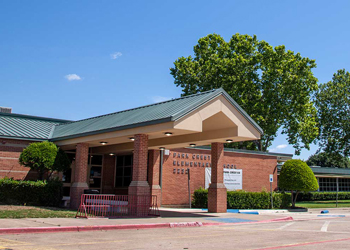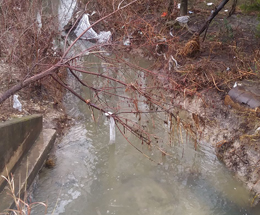A meeting that included attendees from several entities was held Thursday, Aug. 5, at Garland’s City Hall. Meadowlark/Williams Estates Concerned Citizens group, the Environmental Protection Agency (EPA) and Texas Department of State Health Services were represented. In addition, representatives from the Texas Commission on Environmental Quality, Garland Independent School District and the city of Garland were present.
EPA Presentation
The meeting began with Eric Delgado of the EPA providing background information on the Globe Union site and areas affected. The site was assigned to Delgado in March 2020.
Battery manufacturing, Globe Union’s business, produces a variety of wastes. Delgado said that records of regulatory inspections of the Globe Union site by several organizations, including the TCEQ and EPA, date back to 1973. These records indicated compliance with regulations at the time.
A preliminary assessment of the site was performed by the EPA in 2019 to determine potential risks to people’s health or the environment. Another purpose of the assessment was to evaluate the potential for placement on the National Priorities List. That assessment did not show evidence of residual contamination within the facility or in the parking lot.
The EPA concluded that more information was needed and that was taken care of in 2020. It consisted of a collection of soil and sediment along the drainage pathway from Globe Union on South Shiloh Road between Forest Lane and Miller Road. The beginning of Stream 2C4, which was tested, is located across Marquis Street from Globe Union.
Results showed positive contamination levels in the soil samples to the west of the Globe Union site and along Stream 2C4.
The EPA determined that the site was not one of the most contaminated sites in the country.
“But we did acknowledge that further investigation was needed,” Delgado said.
From November 2020 to February 2021, the EPA collected samples from 34 residential properties along the creek in addition to one school, Park Crest Elementary. There are 74 properties in the area but the EPA only gained access to 34 of those as well as the school. They were denied access by seven property owners and another 32 property owners have not returned the requests for access.
Result letters went out in June and July.
They sampled the creek and yards. No lead was found in people’s front yards, which would have indicated aerial deposition. Additionally, no lead was found in the drip lines of the homes. There were 1,068 samples collected from the back, side and front yards. The samples were screened for lead and arsenic.
Of the 1,068 samples, 65 (6%) exceeded the screening values for lead or arsenic.
Delgado said that remediation of this type is straightforward. The contaminated soil is removed, properly disposed of and replaced with clean materials.
He added that as the results of the sampling are reviewed, one must know that “in order for there to be a health risk, from a specific contaminant, the contaminant must be present and individuals must be exposed to that contaminant.”
Both lead and arsenic are harmful. Lead mainly affects the nervous system.
Exposure to arsenic can occur from breathing air, eating some foods, breathing sawdust or smoke from wood treated with arsenic, living in areas with high natural levels in the rock, to name just a few possibilities.
Delgado shared some methods of risk management for before the EPA cleanup action begins. He suggests telling children that they can’t play in the dirt that showed high contamination levels and to take their shoes off before entering the house. He also suggested a healthy diet, watching out for lead in products such as toys and jewelry and suggested checking with your child’s pediatrician.
suggested a healthy diet, watching out for lead in products such as toys and jewelry and suggested checking with your child’s pediatrician.
Delgado said that the cleanup should start at the end of August.
Q&A Session
Zoom attendees and those that were participating from the Garland City Council chambers then participated in Q&A and shared stories of illnesses in their families and themselves.
Q: What about remediation at Park Crest and the creek itself?
A: Delgado – Along with this removal action, we plan to clean up Park Crest as well and all areas along the creek that exceed those screening values.
Q: Would you allow your child to play outside in this area or at Park Crest ES?
A: Delgado – “Well I would most certainly not allow my child to play in the creek that’s burdened with poison ivy. I have a kid that’s really sensitive to it. If somebody told me…there is lead contamination in the creek in the back yard, my responsibility as a parent is to educate my children and say, “Look I know that looks fun but…until something is done, I’d recommend that you stay away from that. So that’s easy.”
Q: Are you comparing poison ivy to lead contamination.
Delgado – “OK. Let me put it this way. What type of lead contamination? Are you talking about high-velocity lead contamination or are you talking about a little bit of lead in the soil? I know that if I go and roll around in poison ivy I’m going to be covered in sores. I know that if I go roll around in an area that has lead contamination, as long as I’m not inhaling or eating that dirt, I can go inside, I can take a shower and I can mitigate that risk. So, I’m not comparing poison ivy to lead contamination or saying one is worse than the other.
We have to use good sense identifying where the lead is and trying to keep people out of it. And if we can’t keep people out of it, then it’s our responsibility, as parents to educate our children. To say, “Hey, I don’t want you bringing in your shoes. I do that with my kids after they play soccer.”
A speaker later noted that children wouldn’t follow all these precautions. She also pointed out that many of the families in that area are low-income. The kids might not be able to go in and take a shower because their water sometimes gets turned off for nonpayment.
Q: How soon is this going to be addressed?
A: Delgado – It will start at the end of August.
Q: Will this affect freshwater drinking sources?
A: Delgado – No.
Q: Is the school in danger?
A: Delgado – The problems at the school were outside of any play area at Park Crest Elementary…The school has done a really good job of mitigation efforts to reduce exposure. They put up signage and a fence where lead was found; they talked to their staff; they’ve let people know where these areas are; in the garden area, they put up temporary fencing to keep folks out. In the parkway area, they have put in mulch to further reduce exposure. They will also water heavily. “I believe that the risk mitigation efforts taken by the district are sufficient to minimize risk.”
staff; they’ve let people know where these areas are; in the garden area, they put up temporary fencing to keep folks out. In the parkway area, they have put in mulch to further reduce exposure. They will also water heavily. “I believe that the risk mitigation efforts taken by the district are sufficient to minimize risk.”
Q: Is there compensation for property value decrease?
A: Delgado – No. You’ll get a letter that says that your property is now clean so that if you want to sell, you’ll have a letter to prove that it has been remediated.
Q: What about houses across Shiloh Road from Globe Union.
A: Delgado – We looked along the waterway. If we would have found stuff in people’s front yards that was from aerial deposition, we probably would have stepped out some more. We had no evidence that supported moving out farther.
Q: Is contamination so bad if kids grow up here playing as kids will, will they have lasting health effects?
A: Delgado – I think what I would have done as a parent when I heard about it is I would have taken him to get his blood tested for lead. Also, just because it is present, doesn’t mean exposure has taken place.
Would I want my kids playing where there are elevated levels of lead? Absolutely not, but you have to think about the dose assessment. Is this something that is so high that they are going to have acute effects from it? In some areas, it might be, but generally, the levels we are finding along the creek are falling into the chronic area of adverse effects. If you are concerned, get their blood tested.
Q: Is there pollution blocks away from the creek?
A: Delgado – No. From Globe Union, no. From other sources, potentially. I’m not aware.
Q: Did the EPA tell GISD they could clean up their own property.
A: Delgado – It’s America. If the school wanted to, it’s their property, they can do it.
Q: The speaker asked someone to say – in these words – that it’s “safe for kids to be at Park Crest.”
A: Texas Department of State Health Services – After lots of numbers and calculations, yes, it’s safe for kids to be there based on the data they have right now but they do need to keep away from where levels are elevated…for the areas they are around, they’re OK.
Q: Why didn’t Garland move sooner on this and where does the buck stop?
A: Bryan Bradford, city manager – I have…heard the stories of how this issue has come forward and wasn’t treated with the degree of seriousness that it should have been…I’ll confess that I haven’t been here long enough to know that history. We have searched our files…and have not been able to find anything. When this issue first came to light for me was Nov. 2, 2018, when Don Phillips took the time to explain the history of the issues. Garland set aside funding for scientifically valid tests to prove or disprove the allegations.
That was important to get the EPA and state’s cooperation and attention on this issue…The city of Garland cooperated in getting those tests. They happened in September 2020 and we all know now what the results were. Our council went to work and so did state representatives. The city has a minor role in cleanup but we continue to cooperate to provide assistance that we can. We don’t have legal jurisdiction to do what these agencies can do. Since we found it, we’ve been hard at work.
Q: Why did GISD not say something sooner?
A: Paul Gonzales, GISD – I came to work as a director for GISD in 2014 and during my tenure working on the campuses was not notified that there was a lead issue. It wasn’t until Wednesday, Jan. 22, 2020, that I got notified by TCEQ that they wanted to get on the property. A letter was sent to the district stating that there were issues at Park Crest ES. The district hired a third party to do their own testing and found out there were issues. They were only looking for lead – not arsenic. He received the final report in July.
Q: From Don Phillips to Eric Delgado – When the EPA asked for permission to go on the campus, were you denied access to their property the first time. Or did you tell me that you were denied access?
A: Delgado – No, I did not say that. They never denied us access.
Phillips said that was not true. He also announced that 42 new samples have now been taken from additional areas.
Q: Can lead be transferred through the air?
A: Delgado – Lead can be transferred through the air – yes it can. Along the creek and vegetative areas, there won’t be lots of transferring unless it is being disturbed.
During the Q&A session, Paul Gonzales from GISD announced that Garland ISD is going to test for contamination at Sam Houston Middle School.
Delgado announced that he would like to move away from the finger-pointing.
“Let’s be solution-oriented,” he said.
More information is available here.
Park Crest ES and Sam Houston MS photos from Garland ISD website.


